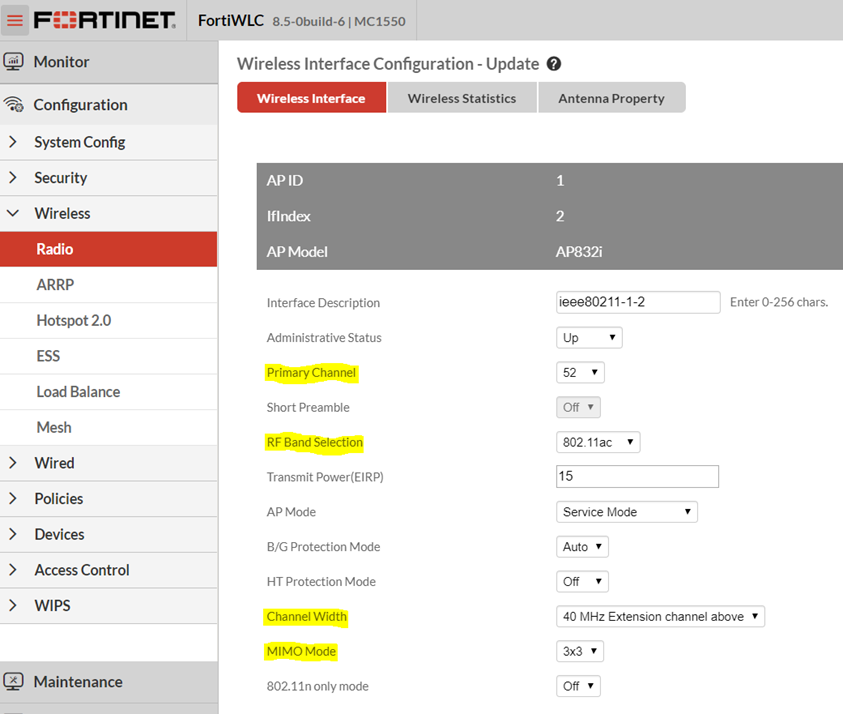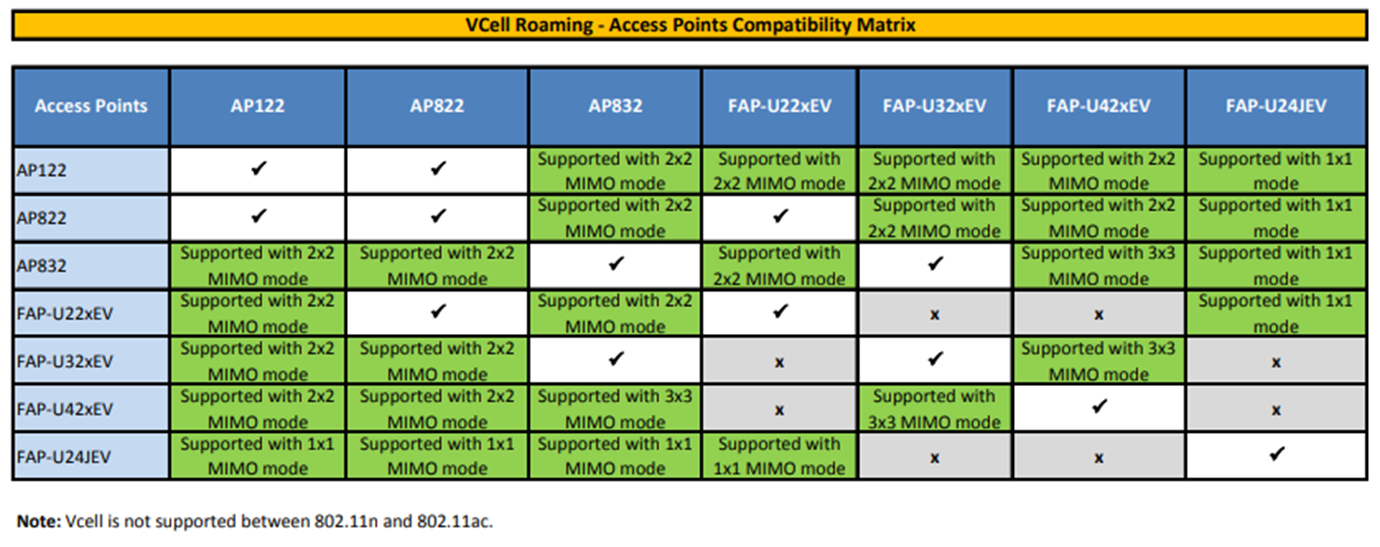- Forums
- Knowledge Base
- Customer Service
- FortiGate
- FortiClient
- FortiAP
- FortiAnalyzer
- FortiADC
- FortiAuthenticator
- FortiBridge
- FortiCache
- FortiCarrier
- FortiCASB
- FortiConnect
- FortiConverter
- FortiCNP
- FortiDAST
- FortiDDoS
- FortiDB
- FortiDNS
- FortiDeceptor
- FortiDevSec
- FortiDirector
- FortiEDR
- FortiExtender
- FortiGate Cloud
- FortiGuard
- FortiHypervisor
- FortiInsight
- FortiIsolator
- FortiMail
- FortiManager
- FortiMonitor
- FortiNAC
- FortiNAC-F
- FortiNDR (on-premise)
- FortiNDRCloud
- FortiPAM
- FortiPortal
- FortiProxy
- FortiRecon
- FortiRecorder
- FortiSandbox
- FortiSASE
- FortiScan
- FortiSIEM
- FortiSOAR
- FortiSwitch
- FortiTester
- FortiToken
- FortiVoice
- FortiWAN
- FortiWeb
- Wireless Controller
- RMA Information and Announcements
- FortiCloud Products
- ZTNA
- 4D Documents
- Customer Service
- Community Groups
- Blogs
Wireless Controller
Dedicated Wi-Fi control and management for high density and mobility
- Fortinet Community
- Knowledge Base
- Wireless Controller
- Technical Tip: How to find a broken virtual cell i...
Options
- Subscribe to RSS Feed
- Mark as New
- Mark as Read
- Bookmark
- Subscribe
- Printer Friendly Page
- Report Inappropriate Content
Description
A common issue with Fortinet Virtual Cell technology is if an Access Point is misconfigured, then it results in Wireless clients performing a ‘hard hand off’, when roaming between AP’s.
This article explains how to find a misconfigured AP radio to ensure seamless roaming by ensuring all radios in the ESS profile are broadcasting the same BSSID.
Solution
When an ESS (Extended Service Set) Profile is created on a Fortinet Wireless Controller and the virtualization mode is set to ‘Virtual Cell’ all Access Point (AP) radios which are part of the virtual cell will broadcast a common BSSID ( per band, i.e. 2.4GHz or 5GHz).
This common BSSID enables the Fortinet Wireless Controller (and not the client) to determine when a unit is moved between access points; from the Wireless client’s perspective it is still connected to the same AP.
In order for a common BSSID to be broadcast however, certain radio parameters for each Access Point in the ESS Profile need to be set identically.
This includes: the radio channel, the channel width, the RF Band and the MIMO mode.
If any of these radio parameters are different, then the AP radio in the same Virtual Cell will broadcast a different BSSID, thus resulting in a hard handoff when the unit roams which can results in Wi-Fi drop outs and jitter.
An easy way to find an AP radio that is misconfigured (or to audit the Virtual Cell ESS profiles) is to use the WLC’s command line interface to display a list of all BSSID, while filtering it for a particular ESS profile.
This is possible using the command: show ess-ap in conjunction with the ESS profile name listed after a pipe ‘ | ’ symbol.
This way filter the results is possible and see a complete list of all the BSSID’s, just for a particular ESS Profile.
Any AP radio that has a different BSSID will have at least one of the aforementioned parameters set differently to the others.
The command to use is:
A common issue with Fortinet Virtual Cell technology is if an Access Point is misconfigured, then it results in Wireless clients performing a ‘hard hand off’, when roaming between AP’s.
This article explains how to find a misconfigured AP radio to ensure seamless roaming by ensuring all radios in the ESS profile are broadcasting the same BSSID.
Solution
When an ESS (Extended Service Set) Profile is created on a Fortinet Wireless Controller and the virtualization mode is set to ‘Virtual Cell’ all Access Point (AP) radios which are part of the virtual cell will broadcast a common BSSID ( per band, i.e. 2.4GHz or 5GHz).
This common BSSID enables the Fortinet Wireless Controller (and not the client) to determine when a unit is moved between access points; from the Wireless client’s perspective it is still connected to the same AP.
In order for a common BSSID to be broadcast however, certain radio parameters for each Access Point in the ESS Profile need to be set identically.
This includes: the radio channel, the channel width, the RF Band and the MIMO mode.
If any of these radio parameters are different, then the AP radio in the same Virtual Cell will broadcast a different BSSID, thus resulting in a hard handoff when the unit roams which can results in Wi-Fi drop outs and jitter.
An easy way to find an AP radio that is misconfigured (or to audit the Virtual Cell ESS profiles) is to use the WLC’s command line interface to display a list of all BSSID, while filtering it for a particular ESS profile.
This is possible using the command: show ess-ap in conjunction with the ESS profile name listed after a pipe ‘ | ’ symbol.
This way filter the results is possible and see a complete list of all the BSSID’s, just for a particular ESS Profile.
Any AP radio that has a different BSSID will have at least one of the aforementioned parameters set differently to the others.
The command to use is:
# show ess-ap | <ESS_profile_here>>
In the example below, an ESS Profile called Voice_5G is filtered to see where the broken virtual cell is.
In the output that the 5GHz radio (Interface Index 2) on AP ID 176 has a different channel width configured, and was therefore broadcasting a different ESSID as highlighted.
Any voice client that roamed to this Access Point have noticed some jitter or drop outs on the call.# show ess-ap | Voice_5GIf a Broken Virtual Cell is found:
ESS Profile APID AP Name If Index Channel Operating Channel Admin State Max Calls BSSID
Voice_5G 176 AP-176 Level 3 2 149 149 Up 0 00:0c:e6:02:b6:d5
Voice_5G 166 AP159 Level 2 2 36 36 Up 0 00:0c:e6:02:82:4a
Voice_5G 174 AP-174 Plant A 2 36 36 Up 0 00:0c:e6:02:82:4a
Voice_5G 175 AP-175 Plant B 2 36 36 Up 0 00:0c:e6:02:82:4a
Voice_5G 10 AP-13 Hall F 2 36 36 Up 0 00:0c:e6:02:82:4a
Voice_5G 103 AP-45 Hall G 2 36 36 Up 0 00:0c:e6:02:82:4a
Voice_5G 104 AP-81 Level 5 2 36 36 Up 0 00:0c:e6:02:82:4a
Voice_5G 105 AP- 82 Level 3 2 36 36 Up 0 00:0c:e6:02:82:4a
Voice_5G 106 AP-113 Level 2 2 36 36 Up 0 00:0c:e6:02:82:4a
Voice_5G 107 AP-112 Near to 2 36 36 Up 0 00:0c:e6:02:82:4a
Voice_5G 110 AP-92 Halls L 2 36 36 Up 0 00:0c:e6:02:82:4a
Voice_5G 112 AP-94 Hall H 2 36 36 Up 0 00:0c:e6:02:82:4a
Voice_5G 115 AP-111 Hall J 2 36 36 Up 0 00:0c:e6:02:82:4a
Voice_5G 116 AP-110 Foyer 2 36 36 Up 0 00:0c:e6:02:82:4a
Voice_5G 117 AP-104 Level 6 2 36 36 Up 0 00:0c:e6:02:82:4a
Voice_5G 118 AP-121 Stage 2 2 36 36 Up 0 00:0c:e6:02:82:4a
Voice_5G 119 AP-78 Stage 3 2 36 36 Up 0 00:0c:e6:02:82:4a
If after running the above command, an AP in a Virtual cell is broadcasting a different BSSID, find it, edit that AP radio and see what differs from the rest of the Access Points.
To do this, from the Forti-WLC’s web GUI select the following:
1) Go to Configuration -> Wireless -> Radio to open the relevant section.
2) enter the AP ID number and AP Index (1 is typically 2.4GHz & 2 is 5GHz radio) in the boxes along the top and then enter to filter the table and highlight the affected AP radio
3) Select 'edit' (pencil icon), as shown below.
In the next section, check each of the highlighted items (Channel, Channel Width, RF Band and MIMO Mode) and compare to any other AP radio which is broadcasting the a common BSSID.
At least one will be different.
Note: Changing radio parameter will result in the Access Point rebooting.
To verify, use the following command:# show ess-ap | <ESS_profile_here>The Access Point is now broadcasting the same BSSID
Note: If the AP is not broadcasting the SSID it is because ???? .... check these steps ????
If there is a mixture of Access Point models?
Even if there is a mixture of AP models, a Virtual Cell can be created in certain situations by editing the AP radios as shown above.
Refer to the compatibility matrix below.Related Articles
Meru Technical Note - AP command to display the BSSIDs of the radio for each ESS profile
Meru Technical Note - What is Shared BSSID and Per-station BSSID?
Broad. Integrated. Automated.
The Fortinet Security Fabric brings together the concepts of convergence and consolidation to provide comprehensive cybersecurity protection for all users, devices, and applications and across all network edges.
Security Research
Company
News & Articles
Copyright 2024 Fortinet, Inc. All Rights Reserved.


